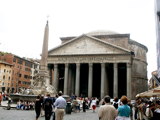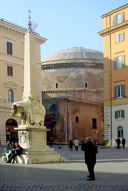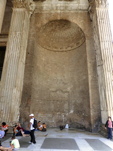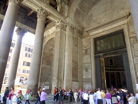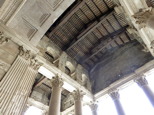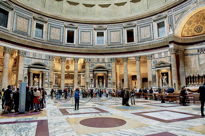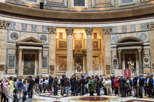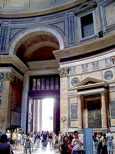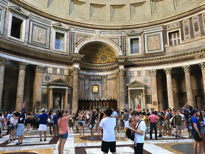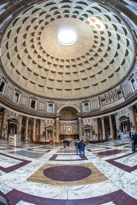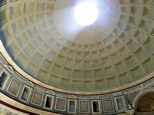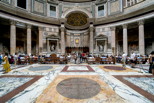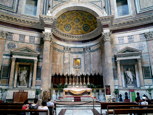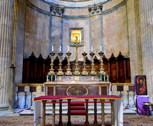Santa Maria ad Martyres, also known as the
Pantheon, is a 1st century Roman temple that was consecrated as a church in the 7th century.
For reference, a plan of the church is available
here.
It was built by Emperor Trajan, and completed by his adopted son Hadrian, between ca. 114 and 128, to replace a temple built by Marcus Vipsanius Agrippa, companion of Augustus. In 609 the Byzantine Emperor Phocas donated it to Pope Boniface IV who converted it into a Christian church. It was consecrated and dedicated to Our Lady and all the Martyrs on 13 May 609.
In the period when the papacy was based in Avignon (1309-1377), the church fell into disuse and was used at one time as a fortress, and later the portico was used as a poultry market. With the return of the popes to Rome in the early 15th century, the process of civic enhancement of the edifice began. This entailed the clearing away of the houses stuck to the rotunda, and also demolishing those in front of the church to create a piazza. The medieval accretions were cleared by order of Pope Eugenius IV (1431-39) and the piazza was laid out and paved. In the center of the piazza is a fountain, the
Fontana del Pantheon, surmounted by an Egyptian obelisk. The fountain was constructed by
Giacomo Della Porta under Pope Gregory XIII in 1575, and the obelisk was added to it in 1711 under Pope Clement XI. The surrounding buildings are 18th and 19th century.
The Renaissance saw the building become the focus of admiration. In 1520, Raphael was buried here and other great artists such as Annibale Caracci and Taddeo Zucchero followed his example. Also, the fifteen altars started to be adorned with high quality altarpiece paintings in this century. Pope Pius IV repaired or recast the ancient door in 1563.
In the 20th the first two kings of the united Italy were buried here.

